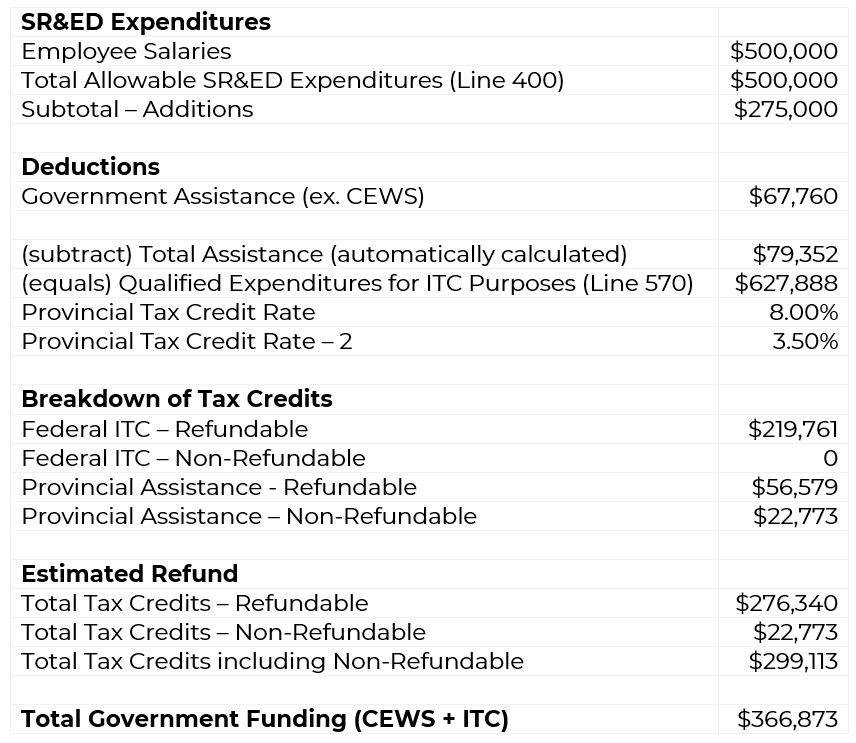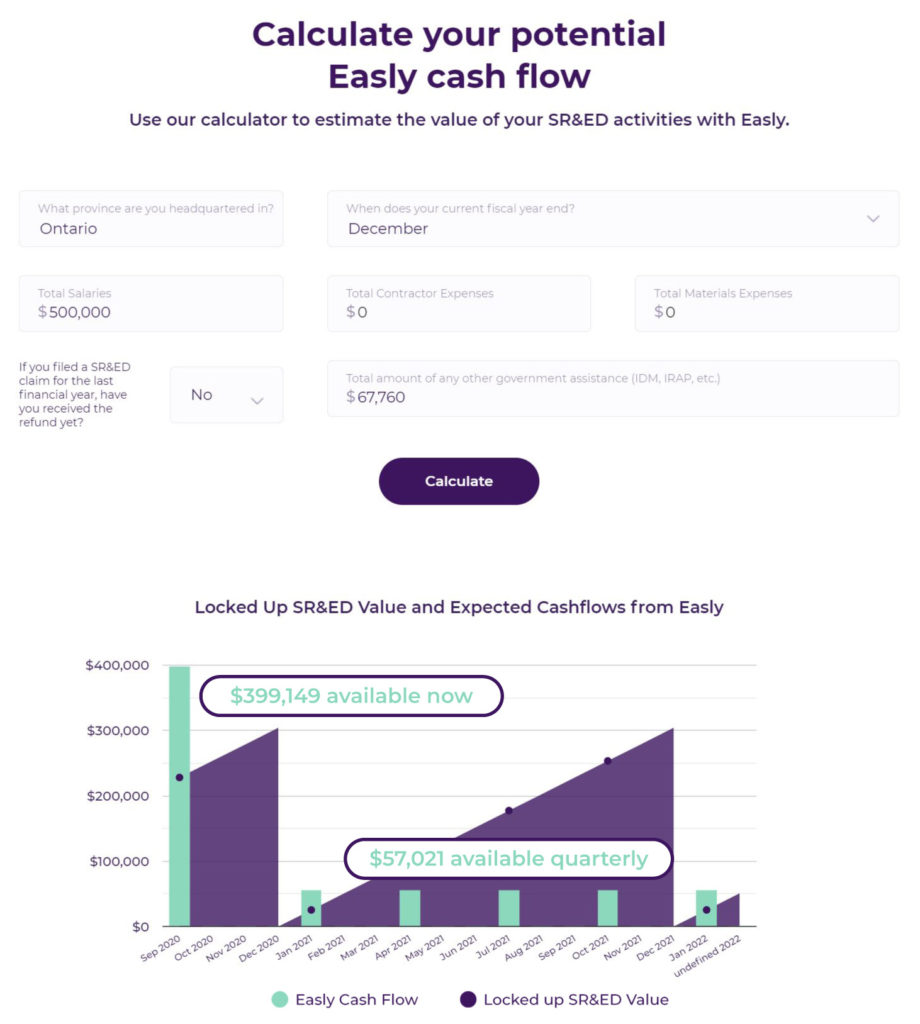
If you normally apply to the Scientific Research and Experimental Development (SR&ED) program, you may be wondering how COVID-related funding will impact your refund. This article discusses COVID funding, how government assistance is treated for SR&ED, and how accessing SR&ED financing can help your organization not just survive but thrive in this new era.
COVID Funding – Canada Emergency Wage Subsidy (CEWS)
The purpose of the Canada Emergency Wage Subsidy (CEWS) program is to help employers rehire or keep existing employees if their revenue has decreased due to COVID-19 and to help position Canadian companies to resume normal operations once the crisis has passed. CEWS rates vary per application period.
For claim periods 1 to 4 (March 15th to July 4th, 2020):
- You must meet a minimum of 15% (period 1) or 30% (periods 2 to 4) revenue drop to qualify for the subsidy.
- If you qualify for a period, you automatically qualify for the following period.
- The subsidy rate is 75% of eligible employees’ remuneration, up to a maximum of $847/week per eligible employee.
- Employees who were unpaid for 14 or more consecutive days in the period can’t be included in your calculation.
For claim periods 5-9 changes were made to the calculations; the subsidy rate varies depending on how much revenue has dropped:
- Use the current period’s revenue drop or the previous period’s, whichever works in your favour. For periods 5 and 6, if your revenue dropped at least 30%, your subsidy rate will be at least 75%.
- Even if your revenue has not dropped for the claim period, you can still qualify if your average revenue over the previous three months dropped more than 50%.
- The maximum base subsidy rate is 60% in claim periods 5 and 6.
- The maximum base subsidy rate will begin to decline in claim period 7, gradually reducing to 20% in period 9.
There are scenarios where you may be eligible for a top-up based on losses from the previous 3 months, primarily for companies hit especially hard (loss of revenue 50% or more over a 3-month span). Please see the CRA website for more information.[1]
COVID Funding – 10% Temporary Wage Subsidy (TWS)
The 10% Temporary Wage Subsidy (TWS) for Employers is a 3-month program that allows eligible employers to reduce the amount of payroll deductions they need to remit to the CRA. The subsidy is equal to 10% of the remuneration you pay from March 18 to June 19, 2020, up to $1,375 per eligible employee. The maximum total per employer is $25,000.[2]
COVID Funding – How Does It Impact SR&ED?
For the purposes of SR&ED, CEWS and TWS are considered government assistance. Only the portion of CEWS and TWS received which are for employees conducting SR&ED eligible work should be claimed in line 431 and line 515.
These will reduce your pool of eligible SR&ED expenditures and therefore decrease your overall investment tax credit (ITC). Do not despair; it is beneficial to take government assistance overall.
SR&ED and Government Assistance – How They Work Together
The example below shows that if government support is accepted, your SR&ED ITC will be lower, but the government’s overall amount of funding will be higher.
Scenario:
- Your Ontario-based company has five employees doing 100% SR&ED eligible work. They are paid $100,000 each ($500,000 total).
- You accept CEWS for them ($847/week for periods 1-4) 847 x 5 = $4,235/week. $4,235 x 16 weeks = $67,760.
- In the SR&ED ITC calculation your expenses will be $775,000 (base salary + 55% proxy*).
- When CEWS is deducted this amount becomes $707,240.
- Provincial amounts are then deducted (just the way the calculation works) which moves the total amount on which the tax credit is calculated down to ~$627,888.
- Your tax credits are then calculated on the ~$627,888.
- The refund will be $299,113 (refundable + non refundable).
- The total value of CEWS ($67,760) + SRED ($299,113) is $366,873. (Yes, the math is correct!)

(*Assumes there are no issues with the Prescribed Proxy Amount Policy cap.)
If you have been using COVID funding to help your company during this trying time, continue to do so. Government funding may reduce your overall investment tax credits, but you will still come out ahead in the long run. For more information, please see our colleagues over at SR&ED Education and Resources and their example post.
How can Easly’s SR&ED Financing Solution Help Bridge the Gap?
Easly’s SR&ED financing helps companies access their SR&ED ITCs earlier. Funding can begin in as little as two weeks from applying.. After the initial financing has been sent, more capital becomes available every quarter based on accrued SR&ED expenditure. All principal, interest and fees are recouped directly from the CRA refund, keeping the whole process cash flow positive to companies.
Here’s an example of a company’s potential Easly cash flow using the same numbers from the example above:

Easly’s Capital-as-a-Service (CaaS) platform can help bridge that gap between COVID funding and waiting for your SR&ED ITC refund. CaaS provided throughout the year helps companies cover expenditures as they are incurred rather than waiting for their ITC to be paid. This may help keep your SR&ED projects going and allow you to pay your employees. This is critical during these trying times as so many companies must layoff employees due to a loss in revenue.
Conclusion
COVID funding has been vital in keeping many companies operating during this incredibly trying time. Unfortunately, this support is beginning to be phased out. Luckily, Easly’s SR&ED financing solution is available to help these companies continue to operate and keep cash flowing throughout the year.
Please contact us to see if we can help you with your SR&ED financing.
[1] Canada Revenue Agency. (n.d.). [No title]. Retrieved August 31, 2020, from https://www.canada.ca/en/revenue-agency/services/subsidy/emergency-wage-subsidy/cews-what-changes.html
[2] 10% Temporary Wage Subsidy for Employers. (2020, July 31). https://www.canada.ca/en/revenue-agency/services/subsidy/temporary-wage-subsidy.html
.png)
.png)
.png)
